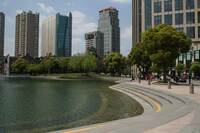- England
- Scotland
- France
- Holland
- Germany
- Italy
- Spain
- Portugal
- USA
- China
- Japan
- India
- Iran
- Advice
- Gardens
- England
- Scotland
- France
- Holland
- Germany
- Italy
- Spain
- Portugal
- USA
- China
- Japan
- India
- Iran
- Advice
- Garden Tours
Book: Landscape Planning and Environmental Impact Design: from EIA to EID
Chapter: Chapter 4 Public open space POS
Public open space should radiate public goods. This idea differs from the old concept of a 'park' as an enclosed space. New public open spaces in towns should be designed, like Shanghai's Tai Ping Qiao Park (Xintiandi district, designed by SOM) to benefit the surrounding urban area. In the latter part of the twentieth century, the most appealing approach to the integration of open space types within cities is by means of a Green Web [Fig 4.27]. 4.27 The historic approaches to distributing open space in cities can be combined by means of a Green Web, interlinking town (left) and country (right). Public open spaces can be interlinked with footpaths, bridges, cycleways, bridlepaths, stream valleys, linear parks, waterfront reservations, covered arcades, elegant streets and greenways of every type. The difference between a green web and a park system is that many spaces in the web should be 'green' not in colour, but in the sense that political parties are said to be 'green' (Porritt 1984: 3). Just as 'blue' movies are not filmed in blue so 'green space' need not be festooned with greenery. The web should be composed of environmentally delightful open space in which people are free to move without aggravation from noise, pollution, danger or other harmful side effects. Streets can be included if the traffic flow does not constitute a menace to health and safety. Linked 'green' space has both philosophical and practical advantages. Lynch outlines the philosophical aspect as follows: 'The openï¾space system not only makes the city visible, but also the larger natural universe. It can give the observer a sense of the more permanent system of which he and the city are only parts... To convey a sense of the web of life, of the intricate interdependent system of living things, will be even more important' (Lynch 1972). The practical advantages are comparable to those of telephone and transport networks: even if an individual uses only a small part of the network, he gains access to the system, and knows that he can use all of its parts. An extension of the 'green' web out into the countryside will assist in the management of urban fringe land. Parts of the web without public access can be made into common land. Its ownership, like all traditional commons, would remain in private hands, but the new commoners would purchase such rights as they wished to own. The most important right is access. Disputes could be dealt with by a modern equivalent of manorial courts. The new commons should extend into urban areas, as green wedges, and out into the countryside, as 'amenity corridors'. Where possible they should follow landscape features, such as hills or valleys, and connect up with an international system of longï¾distance footpaths. Special maps should be produced, like road or rail maps, but showing the green web and the different kinds of open space to which it gives access. Use of the system for commuting and leisure journeys, would provide the visual policing which deters crime. Compared to our ancestors, we travel more and congregate less. For many people movement is a pleasure in itself. It forms the substance of recreational activities: hiking, jogging, horseï¾riding, cycling, canoeing, sailing etc. These pastimes cannot be accommodated satisfactorily in public gardens or city streets. Nor is there space for them in leafy suburbs, where most of the 'green' space is private, or in small country villages, where the 'green' fields and woods have signs saying 'Keep Out. Trespassers will be prosecuted and dogs shot'. The green web, should have a great range of specialised facilities for outdoor recreation: an urban wilderness, a town forest, a metropolitan dryï¾ski centre, public orchards, wellï¾stocked fishing lakes, scrubland in which to gather berries and nuts, a gasworks park, commons on which individuals can keep grazing animals, camping and caravan sites, an arboretum and botanical garden, a windy ridge for kite flying and hangï¾gliding, an athletics centre, swimming lakes, adventure areas, a great bowl for outdoor events, a sumptuous flower garden, outdoor museums for large exhibits, BMX and motorcycle scrambling pits. Lessï¾specialised open spaces can be made wherever there is a local demand. People can live beside those areas which best suit their own tastes and preferences in open space. Urban areas would be less monotonous. Green webland should radiate public goods.

